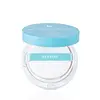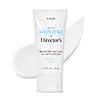What's inside
What's inside
 Key Ingredients
Key Ingredients

 Benefits
Benefits

 Concerns
Concerns

 Ingredients Side-by-side
Ingredients Side-by-side

Water
Skin ConditioningButyloctyl Salicylate
Skin ConditioningEthylhexyl Isononanoate
EmollientCI 77891
Cosmetic ColorantC12-15 Alkyl Benzoate
AntimicrobialPropanediol
SolventIsononyl Isononanoate
EmollientCaprylyl Methicone
Skin ConditioningDibutyl Adipate
EmollientPropylheptyl Caprylate
EmollientPolyglyceryl-4 Oleate
EmulsifyingGlycerin
HumectantDiethylamino Hydroxybenzoyl Hexyl Benzoate
UV FilterPhenethyl Benzoate
EmollientSilica
AbrasiveChlorella Vulgaris Extract
Skin ConditioningCentella Asiatica Extract
CleansingVincetoxicum Atratum Extract
Skin ConditioningCalamine
AbsorbentEthylhexyl Triazone
UV AbsorberPolypropylsilsesquioxane
Disteardimonium Hectorite
StabilisingPolyhydroxystearic Acid
EmulsifyingHectorite
AbsorbentMagnesium Sulfate
Polyglyceryl-3 Polyricinoleate
EmulsifyingAluminum Hydroxide
Emollient1,2-Hexanediol
Skin ConditioningMethylene Bis-Benzotriazolyl Tetramethylbutylphenol
UV FilterLauryl Polyglyceryl-3 Polydimethylsiloxyethyl Dimethicone
Skin ConditioningStearic Acid
CleansingButylene Glycol
HumectantHydroxyacetophenone
AntioxidantGlucose
HumectantFructooligosaccharides
HumectantFructose
HumectantPolyglyceryl-2 Dipolyhydroxystearate
Skin ConditioningDecyl Glucoside
CleansingDipotassium Glycyrrhizate
HumectantTocopherol
AntioxidantEthylhexylglycerin
Skin ConditioningAllantoin
Skin ConditioningEctoin
Skin ConditioningPanthenol
Skin ConditioningFructan
Skin ConditioningMadecassoside
AntioxidantAsiaticoside
AntioxidantBeta-Glucan
Skin ConditioningMadecassic Acid
Skin ConditioningAsiatic Acid
Skin ConditioningXanthan Gum
EmulsifyingWater, Butyloctyl Salicylate, Ethylhexyl Isononanoate, CI 77891, C12-15 Alkyl Benzoate, Propanediol, Isononyl Isononanoate, Caprylyl Methicone, Dibutyl Adipate, Propylheptyl Caprylate, Polyglyceryl-4 Oleate, Glycerin, Diethylamino Hydroxybenzoyl Hexyl Benzoate, Phenethyl Benzoate, Silica, Chlorella Vulgaris Extract, Centella Asiatica Extract, Vincetoxicum Atratum Extract, Calamine, Ethylhexyl Triazone, Polypropylsilsesquioxane, Disteardimonium Hectorite, Polyhydroxystearic Acid, Hectorite, Magnesium Sulfate, Polyglyceryl-3 Polyricinoleate, Aluminum Hydroxide, 1,2-Hexanediol, Methylene Bis-Benzotriazolyl Tetramethylbutylphenol, Lauryl Polyglyceryl-3 Polydimethylsiloxyethyl Dimethicone, Stearic Acid, Butylene Glycol, Hydroxyacetophenone, Glucose, Fructooligosaccharides, Fructose, Polyglyceryl-2 Dipolyhydroxystearate, Decyl Glucoside, Dipotassium Glycyrrhizate, Tocopherol, Ethylhexylglycerin, Allantoin, Ectoin, Panthenol, Fructan, Madecassoside, Asiaticoside, Beta-Glucan, Madecassic Acid, Asiatic Acid, Xanthan Gum
Water
Skin ConditioningIsononyl Isononanoate
EmollientZinc Oxide
Cosmetic ColorantPropanediol
SolventC12-15 Alkyl Benzoate
AntimicrobialButyloctyl Salicylate
Skin ConditioningTitanium Dioxide
Cosmetic ColorantSilica
AbrasiveHexyl Laurate
EmollientAcrylates Copolymer
Isotridecyl Isononanoate
EmollientPolyglyceryl-4 Diisostearate/Polyhydroxystearate/Sebacate
EmulsifyingPolyglyceryl-2 Isostearate
EmulsifyingPolyglyceryl-2 Dipolyhydroxystearate
Skin ConditioningMagnesium Sulfate
1,2-Hexanediol
Skin ConditioningDisteardimonium Hectorite
StabilisingDimethicone Crosspolymer
Emulsion StabilisingVp/Hexadecene Copolymer
Coco-Caprylate/Caprate
EmollientPolyhydroxystearic Acid
EmulsifyingPolyglyceryl-6 Polyricinoleate
EmulsifyingSorbitan Sesquioleate
EmulsifyingTriethoxycaprylylsilane
Centella Asiatica Extract
CleansingPoly C10-30 Alkyl Acrylate
Emulsion StabilisingAluminum Hydroxide
EmollientSorbitan Isostearate
EmulsifyingStearic Acid
CleansingPolyglyceryl-6 Polyhydroxystearate
EmulsifyingPvp
Emulsion StabilisingCentella Asiatica Flower/Leaf/Stem Extract
Skin ConditioningPolyglycerin-6
HumectantEthylhexylglycerin
Skin ConditioningTocopherol
AntioxidantAscorbyl Palmitate
AntioxidantPanthenol
Skin ConditioningMadecassoside
AntioxidantAsiaticoside
AntioxidantCentella Asiatica Leaf Extract
Skin ConditioningWater, Isononyl Isononanoate, Zinc Oxide, Propanediol, C12-15 Alkyl Benzoate, Butyloctyl Salicylate, Titanium Dioxide, Silica, Hexyl Laurate, Acrylates Copolymer, Isotridecyl Isononanoate, Polyglyceryl-4 Diisostearate/Polyhydroxystearate/Sebacate, Polyglyceryl-2 Isostearate, Polyglyceryl-2 Dipolyhydroxystearate, Magnesium Sulfate, 1,2-Hexanediol, Disteardimonium Hectorite, Dimethicone Crosspolymer, Vp/Hexadecene Copolymer, Coco-Caprylate/Caprate, Polyhydroxystearic Acid, Polyglyceryl-6 Polyricinoleate, Sorbitan Sesquioleate, Triethoxycaprylylsilane, Centella Asiatica Extract, Poly C10-30 Alkyl Acrylate, Aluminum Hydroxide, Sorbitan Isostearate, Stearic Acid, Polyglyceryl-6 Polyhydroxystearate, Pvp, Centella Asiatica Flower/Leaf/Stem Extract, Polyglycerin-6, Ethylhexylglycerin, Tocopherol, Ascorbyl Palmitate, Panthenol, Madecassoside, Asiaticoside, Centella Asiatica Leaf Extract
 Reviews
Reviews

Ingredients Explained
These ingredients are found in both products.
Ingredients higher up in an ingredient list are typically present in a larger amount.
1,2-Hexanediol is a synthetic liquid and another multi-functional powerhouse.
It is a:
- Humectant, drawing moisture into the skin
- Emollient, helping to soften skin
- Solvent, dispersing and stabilizing formulas
- Preservative booster, enhancing the antimicrobial activity of other preservatives
Aluminum Hydroxide is a form of aluminum. It can be naturally found in nature as the mineral gibbsite. In cosmetics, Aluminum Hydroxide is used as a colorant, pH adjuster, and absorbent.
As a colorant, Aluminum Hydroxide may add opacity, or reduce the transparency. Aluminum hydroxide is contains both basic and acidic properties.
According to manufacturers, this ingredient is an emollient and humectant. This means it helps hydrate the skin.
In medicine, this ingredient is used to help relieve heartburn and help heal ulcers.
There is currently no credible scientific evidence linking aluminum hydroxide in cosmetics to increased cancer risk.
Major health organizations allow the use of aluminum hydroxide in personal care products and have not flagged it as a carcinogenic risk at typical usage levels.
Learn more about Aluminum HydroxideAsiaticoside comes from the super popular skin-soothing ingredient, Centella asiatica. It is one of four active compounds found in the extract of Centella Asiatica.
Asiaticoside is an antioxidant and helps with wound healing. It has been shown to increase antioxidant activity during the wound healing process.
Butyloctyl Salicylate is a chemical UV filter structurally similar to octisalate. It is a photostabilizer, SPF booster, emollient and solvent. This ingredient helps evenly spread out ingredients.
According to a manufacturer, it is suitable for pairing with micro Titanium Dioxide, Zinc Oxide, and pigments.
Photostabilizers help stabilize UV-filters and prevents them from degrading quickly.
Learn more about Butyloctyl SalicylateC12-15 Alkyl Benzoate is made up of Benzoic Acid and long chain alcohols. It has a low molecular weight.
C12-15 Alkyl Benzoate is an emollient and texture enhancer. Due to its solubility, it is often used in sunscreens to help evenly distribute active ingredients.
As an emollient, C12-15 Alkyl Benzoate helps soften and hydrate your skin. Emollients create a film on your skin that traps moisture within.
This ingredient has been reported to cause eye irritation.
Learn more about C12-15 Alkyl BenzoateCentella Asiatica Extract (Centella) is derived from an herb native to Southeast Asia. It is famous for its anti-inflammatory and soothing properties.
Centella is rich in antioxidants and amino acids, such as Madecassic Acid and Asiaticoside.
Studies show the compounds in centella help with:
The combination of all these properties makes centella effective at soothing, hydrating, and protecting the skin.
Other great components of centella include Vitamin A, vitamin C, several B vitamins, and Asiatic Acid.
Fun fact: Centella has been used as a medicine and in food for many centuries. As a medicine, it is used to treat burns, scratches, and wounds.
Learn more about Centella Asiatica ExtractDisteardimonium Hectorite comes from the clay mineral named hectorite. It is used to add thickness to a product.
It can also help stabilize a product by helping to disperse other ingredients.
Hectorite is a rare, white clay mineral.
Learn more about Disteardimonium HectoriteEthylhexylglycerin (we can't pronounce this either) is commonly used as a preservative and skin softener. It is derived from glyceryl.
You might see Ethylhexylglycerin often paired with other preservatives such as phenoxyethanol. Ethylhexylglycerin has been found to increase the effectiveness of these other preservatives.
Isononyl Isononanoate is a synthetic skin-conditioner and texture enhancer. It is created from nonanoic acid, a fatty acid found in cocoa and lavender oil.
As an emollient, Isononyl Isononanoate helps keep your skin soft and smooth. This is because emollients create a barrier on the skin to trap moisture in.
Isononyl Isononanoate helps give products a velvet feel and improves spreadability.
Learn more about Isononyl IsononanoateMadecassoside comes from the super popular skin-soothing ingredient, Centella asiatica. It is one of four active compounds found in the extract of Centella Asiatica.
Madecassoside has antioxidant, anti-inflammatory, and hydrating properties. It contains fatty acids, amino acids, beta-carotene, and phytochemicals.
One study found using Madecassoside with ascorbic acid helped reduce the signs of aging and improved skin hydration.
Learn more about MadecassosideMagnesium Sulfate is a salt. More specifically, it is an epsom salt, or the bath salt used to help relieve muscle aches.
Despite having ‘sulfate’ in the name, it isn’t a surfactant or cleansing agent like sodium lauryl sulfate. Unlike those sulfates, magnesium sulfate doesn’t have the same cleansing or foaming properties (it's simply a type of salt).
In cosmetics, Magnesium Sulfate is used to thicken a product or help dilute other solids. It is a non-reactive and non-irritating ingredient.
One study shows magnesium deficiency may lead to inflammation of the skin. Applying magnesium topically may help reduce inflammation.
You can find this ingredient in sea water or mineral deposits.
Learn more about Magnesium SulfatePanthenol is a common ingredient that helps hydrate and soothe the skin. It is found naturally in our skin and hair.
There are two forms of panthenol: D and L.
D-panthenol is also known as dexpanthenol. Most cosmetics use dexpanthenol or a mixture of D and L-panthenol.
Panthenol is famous due to its ability to go deeper into the skin's layers. Using this ingredient has numerous pros (and no cons):
Like hyaluronic acid, panthenol is a humectant. Humectants are able to bind and hold large amounts of water to keep skin hydrated.
This ingredient works well for wound healing. It works by increasing tissue in the wound and helps close open wounds.
Once oxidized, panthenol converts to pantothenic acid. Panthothenic acid is found in all living cells.
This ingredient is also referred to as pro-vitamin B5.
Learn more about PanthenolPolyglyceryl-2 Dipolyhydroxystearate isn't fungal acne safe.
Polyhydroxystearic Acid is a soft wax made from castor oil.
It is is a texture thickener, emulsifier, and film-former. Emulsifiers prevent ingredients from separating, such as oils and waters.
Polyhydroxystearic Acid may not be fungal acne safe.
Learn more about Polyhydroxystearic AcidPropanediol is an all-star ingredient. It softens, hydrates, and smooths the skin.
It’s often used to:
Propanediol is not likely to cause sensitivity and considered safe to use. It is derived from corn or petroleum with a clear color and no scent.
Learn more about PropanediolSilica, also known as silicon dioxide, is a naturally occurring mineral. It is used as a fine, spherical, and porous powder in cosmetics.
Though it has exfoliant properties, the function of silica varies depending on the product.
The unique structure of silica enhances the spreadability and adds smoothness, making it a great texture enhancer.
It is also used as an active carrier, emulsifier, and mattifier due to its ability to absorb excess oil.
In some products, tiny microneedles called spicules are made from silica or hydrolyzed sponge. When you rub them in, they lightly polish away dead skin layers and enhance the penetration of active ingredients.
Learn more about SilicaStearic Acid is a fatty acid. It is an emollient, emulsifier, and texture enhancer.
As an emollient, stearic acid helps soften skin. It aids the skin's protective barrier by preventing water loss. It also provides a gentle cleansing effect without stripping away natural oils.
Stearic acid may also be used to enhance the texture of products. It can add volume and stabilize ingredients such as water and oil. This can help water and oil ingredients from separating.
Sources of stearic acid include animal or vegetable fats/oils such as coconut or shea. It can be naturally found in butter, cocoa butter, shea butter, vegetable fats, and animal tallow.
This ingredient may not be Malassezia folliculitis, or fungal-acne safe.
Learn more about Stearic AcidTocopherol (also known as Vitamin E) is a common antioxidant used to help protect the skin from free-radicals and strengthen the skin barrier. It's also fat soluble - this means our skin is great at absorbing it.
Vitamin E also helps keep your natural skin lipids healthy. Your lipid skin barrier naturally consists of lipids, ceramides, and fatty acids. Vitamin E offers extra protection for your skin’s lipid barrier, keeping your skin healthy and nourished.
Another benefit is a bit of UV protection. Vitamin E helps reduce the damage caused by UVB rays. (It should not replace your sunscreen). Combining it with Vitamin C can decrease sunburned cells and hyperpigmentation after UV exposure.
You might have noticed Vitamin E + C often paired together. This is because it is great at stabilizing Vitamin C. Using the two together helps increase the effectiveness of both ingredients.
There are often claims that Vitamin E can reduce/prevent scarring, but these claims haven't been confirmed by scientific research.
Learn more about TocopherolWater. It's the most common cosmetic ingredient of all. You'll usually see it at the top of ingredient lists, meaning that it makes up the largest part of the product.
So why is it so popular? Water most often acts as a solvent - this means that it helps dissolve other ingredients into the formulation.
You'll also recognize water as that liquid we all need to stay alive. If you see this, drink a glass of water. Stay hydrated!
Learn more about Water